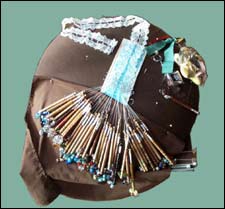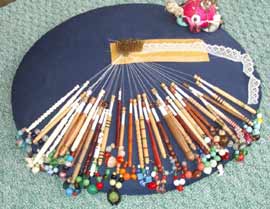In Alison Uttley’s 1950 book Buckinghamshire (County Books series), she writes the following about the introduction of lace to England:
‘Bone lace is mentioned in 1577, about that time Flemish weavers and lace makers fled to England, bringing their crafts. Some of these settled in Olney, Newport Pagnell and this part of the county, with Hanslope and Stony Stratford the strongest centres for lace making.’

The picture above shows how lace is made on pillows. In the past the pillows were stuffed with cut straw and placed on a stand, on a table or across the knees. Today other materials are used in the pillows, quite often a block of polystyrene.


In Memorials of Old Buckinghamshire (1901) by P H Ditchfield says:
‘Newport Pagnell seems to have been the great market, as well as the technical centre, of the lace trade, whence manufacturing districts, and more especially those of Olney and Hanslope, received their patterns, and where they sent their goods to be sold to the lace buyers. In Daniel and Samuel Lysons’ Magna Britannica (1806-1822) we find that lace making is in no part of the country so general as at Hanslope and in its immediate vicinity; it prevails for fifteen to twenty miles round in every direction. At Hanslope no fewer than 800 out of a population of 1275 were employed in it in the year 1801. Children are put to the lace schools at, or soon after, five years of age. At eleven or twelve years of age they are able to maintain themselves without assistance. Both boys and girls are taught to make it, and some, when they are grown up, follow no other employment; others when out of work find it a good resource, and can earn as much as the generality of day labourers. The lace made at Hanslope is from sixpence to two guineas a yard in value. It is calculated that between £8,000 and £10,000 net profit is annually brought into the parish by the lace manufacturers.’


The threads are wound on the bobbins, which have varied designs and are usually made out of wood or bone. They are in themselves works of art, and the varying types were known by picturesque names such as Old Maid’s bobbins; Mothers-in-Babe; Cows-in Calf. Some bobbins were plain and thin; others had little bobbins carved separately inside bigger ones. There were Church Windows, with tiny Gothic openings; Tiger bobbins, with inlaid pewter stripes (see above); Leopard bobbins, with spots; and many others. Girls sent bobbins to young men instead of Valentine cards. The hopes and jokes of generations of simple country people were inscribed on them, at so much per word for the bobbin maker: ‘Love is Love; Marry Me Quick and Lowly Speak; Sitting on a Stile Mary Happy is the Day; Kis Me Court Me Hold Me Tite; Don’t Crump my Hair Tonite; Kis Me Quck My Mome is Comin’. Such were the sentiments of the Hanslope cottage women as they worked by oil lamp with a water-filled globe to magnify the light. In many ways of course it was servitude. Their real skill was not paid for anything like adequately. The cottagers had no real comeback against the hard-nosed bargaining of the lace buyers, and weeks of labour produced little more than a pittance.
The Estate of Edward Watts 1779 survey lists 3 lace dealers in Hanslope: Mr W Kitelee, Mr Phillips and Mr J Hindes.
The 1798 Posse Comitatus of Hanslope lists a number of lace makers and lace dealers.
In his History and Topography of Buckinghamshire (1862), James Joseph Sheahan states that in 1861 500 women and children were still making lace in Hanslope. Liz Bartlett in her book Lace Villages (1991) mentions two lace schools in Hanslope.
In 1801, Hanslope’s population was 1275. 800 people were employed in lace-making. At five years old children were put into lace schools, at eleven or twelve years of age they were able to maintain themselves without assistance.
The most important day of the year in Hanslope was 30 November, St Andrew’s day. The traditional treat for St Andrew’s day was elderberry wine and dough cake.
The demise of lace making as a cottage industry came about with the introduction of machine-made lace centred on Nottingham. Such hand lace-making as survives today does so as a hobby rather than as a business. Lace in Hanslope has gone from being a sweatshop-type cottage industry, employing children from a very young age working in cramped conditions and having to work by candlelight in the evenings, into a hobby today.



